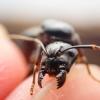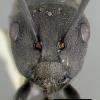I found this lubricant/grease for pipe thread at Home Depot, a local hardware store. There was a huge area that was just full of them, and I picked out one made by RectorSeal, mostly because it said with PTFE. I was looking for a cheaper alternate to buying fluon, so I decided to buy it and test it out. I've never used fluon before, you guys have given pretty good reviews about it out there, and it seems to work well for most/all ants. This grease is able to stop my C. fragilis, which are the most agile and jumpy ants I keep from walking across without falling down.
It's probably not the most trustworthy product at the moment, and it leaves behind a cloudy white smear which looks kind of sketch, but it works well to contain ants. Anyone else have any experience using grease alternatives as anti-slip barriers?




















